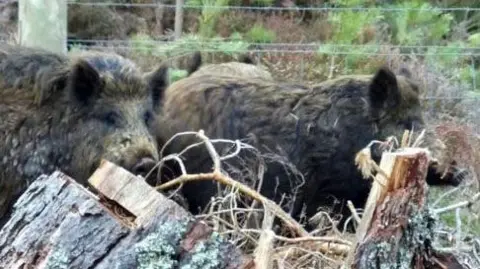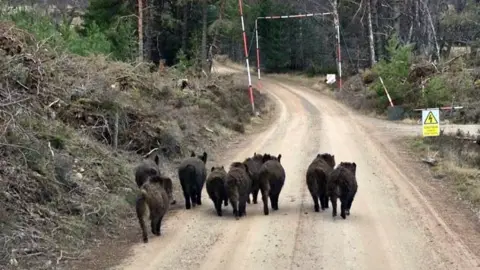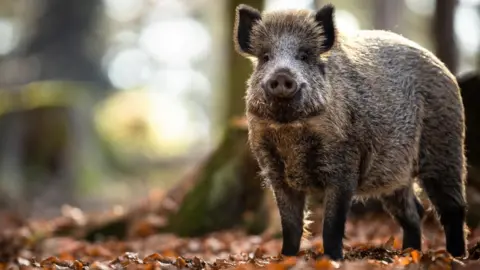Why were the Cairngorms feral pigs killed?
 Greg MacRae
Greg MacRaeA group of feral pigs released illegally in the Cairngorms National Park have been caught and shot dead.
However the culling of the pigs has caused outcry, with hundreds of people leaving comments on the BBC News website's Facebook page, expressing anger and accusing the authorities of animal cruelty.
Some people have questioned why the pigs were treated differently to four lynx that were recently found about five miles from where the pigs were discovered. They were caught and taken to a zoo.
Others have pointed to areas where feral pigs appear to roam freely.
So why were the Cairngorms pigs killed?
What is the history of feral pigs in Scotland?
Wild boar were once native to Scotland but were hunted to extinction 700 years ago.
Captive animals have been imported from continental Europe and kept under licence in zoos, private collections and on farms.
Farmers often crossed wild boar with domesticated pigs to increase their litter size.
There have been numerous escapes from captivity, or deliberate releases, resulting in at least two breeding populations of feral pigs in Scotland.
It is believed they are a mixture of wild boar, domesticated pigs and hybrids.
What is the legal status of feral pigs?
They are classed as a non-native species and because they can cause damage to the environment they are considered to be invasive.
It is an offence under Section 14 of the Wildlife and Countryside Act 1981 to release any type of pig, including wild boar. It is also an offence to allow them to escape from captivity.
Releasing any new species, such as wild boar, requires a licence from Scotland's nature agency NatureScot and it has not issued any such licence.
Wild boar and their hybrids are considered to be dangerous wild animals and they can only be kept under licence under the Dangerous Wild Animals Act 1976.
Why are feral pigs considered to be a problem?
Their rooting behaviour can cause soil erosion, damage plant life, and disturb invertebrates and small mammals. In fragile ecosystems, this can be particularly harmful.
Feral pigs may prey on the eggs of rare ground-nesting birds, negatively impacting biodiversity.
They can cause significant destruction to agricultural fields and private property.
 Greg MacRae
Greg MacRaeFeral pigs can also carry diseases such as African swine fever, foot-and-mouth disease and classical swine fever, which pose risks to livestock and even humans.
The cost of managing feral pig populations, controlling their spread, and mitigating their damage could range from £100,000 to more than £1m in cases of disease outbreaks.
Pigs wandering onto roads can lead to vehicle collisions.
Can feral pigs provide any benefits?
Their rooting can alter soil composition, affecting mineralisation and plant growth.
That can sometimes lead to increased biodiversity by creating habitat mosaics - where different habitats are found closely together.
They contribute to the cycling of nutrients by breaking down organic matter in the soil.
Some populations are maintained for hunting purposes and meat production, which can have economic and recreational benefits.
Who is responsible for feral pigs in Scotland?
Individual land managers are primarily responsible for controlling feral pig populations, and should work in partnership with local communities.
Where feral pigs are present, land managers are encouraged to control their numbers to manage their impacts on agriculture and the environment.
They are not a protected species and they can be shot.
NatureScot has issued best practice advice on controlling the pigs. This includes trapping and shooting them.
Over the last 10 years, populations of free-roaming pigs have become established in Dumfries and Galloway and the Highlands.
What happened in this case?
The feral pigs were seen near Uath Lochans, an area of woodland and small lochs near Kingussie, south of Aviemore, on Monday.
The Cairngorms National Park Authority (CNPA) said earlier this week they were "relatively domesticated" and appeared to have been illegally abandoned.
 Getty Images
Getty ImagesThe Royal Zoological Society of Scotland (RZSS) said they would have been under great stress after being abandoned in a new and "extremely harsh" environment.
Although nine pigs were seen, only eight were caught and killed. It is not known what happened to the ninth pig.
Forestry and Land Scotland said the pigs were taken to an area where they were humanely culled, following expert advice from vets and Police Scotland. It was later established they had been shot.
What is the farming community saying?
Jamie Wyllie, pig committee chairman at the National Farmers' Union (NFU), said: "These animals make controlling disease within farmed animals much more difficult because they can disappear off into the wild. They can harbour disease without any real ability to control them, then they can spread the disease among farms.
"They can carry disease we already have in the pig industry but can also carry disease we don't have such as African swine fever and foot and mouth disease.
"If these diseases come into the country it makes them so much more difficult to contain- and foot and mouth doesn't just affect pigs – it affects all clover-hoof animals."
Philip Lymbery, chief executive of animal welfare campaign group Compassion in World Farming, said he was saddened by the cull.
"Why is it that humankind's only response to these perceived threats is to kill them," he told BBC Scotland.
"Why don't we rescue them, or rehome them, or find another way, a more compassionate way? We have to remember that wild boar were once a natural part of the countryside. Why can't that be the same again, particularly in wild parts of the country?"
He said the spread of disease among farmed animals was because so many of them were kept crammed tightly in huge numbers - "in hundreds, thousands, tens of thousands in factory farms – which are breeding grounds for disease".
He added: "A few feral pigs really isn't where the issue is. Our response to animals should always be kindness first."
What happened with the illegally-released lynx?
Four lynx that were illegally released in the Cairngorms were captured in early January and taken to Edinburgh Zoo - but one soon died.
The three surviving lynx, all young females, have now been through 30 days quarantine and are said to be doing well.
The zoo is now looking for new homes for them.
It is still not known where the lynx came from.
A licence is required under the Dangerous Animals Act to keep lynx.
Highland Council said no premises in the area had applied for, or were operating under a Dangerous Wild Animal (DWA) licence, suggesting the lynx had come from somewhere else.
NatureScot also said it has not granted any licences for the reintroduction of lynx.
Campaigners have been working on plans for the controlled reintroduction of the cats to benefit rural biodiversity but farmers have raised concerns about the impact they would have on livestock.
Last week, First Minister John Swinney ruled out the legal release of lynx into the wild in Scotland, saying the reintroduction of lynx, or any other carnivorous species, would not take place under his government.
